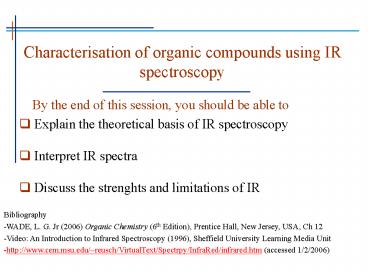Electrolyte conductivity - PowerPoint PPT Presentation
1 / 9
Title:
Electrolyte conductivity
Description:
Video: An Introduction to Infrared Spectroscopy (1996), Sheffield University ... asymmetric) and three bending modes (rocking, scissoring, wagging, twisting) ... – PowerPoint PPT presentation
Number of Views:19
Avg rating:3.0/5.0
Title: Electrolyte conductivity
1
Characterisation of organic compounds using IR
spectroscopy
- By the end of this session, you should be
able to - Explain the theoretical basis of IR spectroscopy
- Interpret IR spectra
- Discuss the strenghts and limitations of IR
- Bibliography
- WADE, L. G. Jr (2006) Organic Chemistry (6th
Edition), Prentice Hall, New Jersey, USA, Ch 12 - Video An Introduction to Infrared Spectroscopy
(1996), Sheffield University Learning Media Unit - http//www.cem.msu.edu/reusch/VirtualText/Spectrp
y/InfraRed/infrared.htm (accessed 1/2/2006)
2
How do we know the synthesis has been successful?
- Has the product the desired structure?
- Is it sufficiently pure?
- We need techniques that work with a tiny amount
of product and do not destroy the sample - Spectroscopic techniques meet these requirements
Absorption spectroscopy is the measurement of the
amount of light absorbed by a compound as a
function of the wavelenght of the light
3
Fundamentals of spectroscopy
- Visible, infrared and ultraviolet light,
microwaves and radiowaves are ELECTROMAGNETIC
RADIATION - They all travel at the speed of light, but differ
in frequency and wavelenght - Frequency (n) number of complete wave cycles
that pass a fixed point in a second (Hz)
- Wavelenght (l) distance between any two crests
or troughs (cm)
4
The electromagnetic spectrum
http//imagers.gsfc.nasa.gov/ems/waves3.html
(23/01/06) http//loke.as.arizona.edu/ckulesa/c
amp/spectroscopy_intro.html (23/01/06)
5
Infrared spectroscopy
- Infrared photons can cause groups of atoms to
vibrate with respect to the bonds that connect
them - The types of vibrations available to a molecule
is determined by the - - Number of atoms
- - Type of atoms
- - Type of bonding between atoms
IR spectroscopy is a powerful technique in
characterising pure inorganic and organic
compounds
6
Infrared spectroscopy
- The position of an infrared band is specified by
its wavelenght (l). The units in IR spectra are
wavenumbers ( ), cm-1 - Two main types of vibration
- There are two stretching (symmetric,
asymmetric) and three bending modes (rocking,
scissoring, wagging, twisting). To see them in
action, go to http//www.shu.ac.uk/schools/sci/ch
em/tutorials/molspec/irspec1.htm (accessed
23/02/05)
7
The IR spectrum
- An infrared spectrometer measures the frequencies
of infrared light absorbed by a compound - The different bonds present in an organic
compound will have characteristic IR absorptions.
There are tables with the characteristic
absorptions of functional groups. - It is very unlikely that two compounds (unless
enantiomers) will have the same frequencies for
all their various complex vibrations - Samples for IR can be solid or liquids
- Solid are mixed with KBr to make a disc, or
mixed with nujol (an inorganic oil) and deposited
over NaCl plates - Liquids can be analysed directly as a thin film
in NaCl plates
8
Strenghts of IR
- An IR spectrum
- Provides an indication of the functional groups
in the compound - Shows the absence of other functional groups that
would give strong absorptions if they were
present - The absence of a signal is proof that the
functional group is absent. - Can confirm the identity of a compound by
comparison with a known sample
9
Limitations of IR
- IR does not provide much information about the C
skeleton or alkyl groups - Some signals may be ambiguous
- You can rarely determine a structure based only
on the IR spectrum

